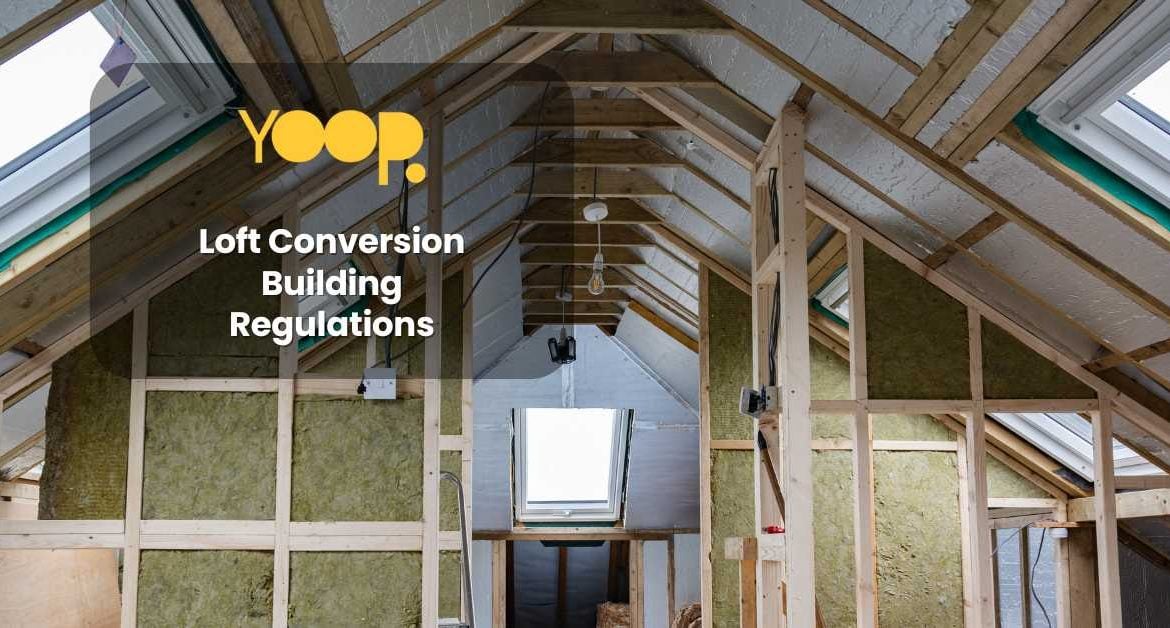
Loft Conversion building regulations
One of the greatest ways to take advantage of the space that you have already without sacrificing the garden or the outside areas is by loft conversion. In many cases, it may not be necessary to apply for planning permission, but Building Regulations are mandatory when it comes to carrying out loft conversion projects in the UK: A conversion is allowed to be safe, functional, and meet the national standards.
This document would provide you with a comprehensive guide into Building Regulations concerning the loft conversion access by Yoop Architects. It will explain the nature of Building Regulation, what they mean, their importance, and how to make sure that your project is within the ambit of the requirement.
Loft Conversion Building Regulations
These are the specific criteria that must be met in order for an existing building to be converted legally into a loft space. The set statutory requirements form basic minimum standards for buildings in terms of safety, energy efficiency, and accessibility. Such regulations for loft conversions include:
- Structural Safety: The loft must be able to take the extra weight
- Fire Safety: There must be relevant escape routes and fire-resistant materials
- Insulation: Thermal and sound
- Ventilation: for air flow and moisture prevention
Staircase Design: Safe, practical access to the loft Since all these requirements have to be fulfilled, there will be site inspections by a Building Control Officer (BCO) at various stages of the project.
Dreaming of a stunning loft conversion building but unsure about regulations? This guide clarifies the Building Regulations in the UK specific to loft conversions. We’ll explore crucial aspects like staircase design, minimum headroom, proper insulation, and fire safety measures. Ensure your loft conversion meets all safety standards and transforms your home legally and worry-free!
Do I need building regulations for a loft conversion?
Building regulations approval is required for a loft conversion building or attic into a liveable space.
The Building Regulations are minimum standards for design, construction and alterations to virtually every building to ensure the safety and health for people in or about those buildings.
Building regulations approval is different to planning permission. You might need both.
Building regulations approval is different to planning permission. You might need both.
- Yoop Architects TWEET THIS
Building Regulations cover key areas
1. Structural Stability
This is probably the priority in a loft conversion. The weight of new space construction should be supported by an existing structure. Floor Joists: Floor may need strengthened joists. Such a roof structure has to be adjusted for the new space, usually requiring the addition of steel beams depending on design. In general, a structural engineer assesses the original building and gives calculations.
2. Fire Safety
Fire safety is one part of loft conversion building regulations. The major requirements include the following:
Escape Routes: Clear, protected escape route to the outside, usually via a staircase,although in some occasions an escape window may also be provided.
Fire Doors: All doors giving access to the loft must be fire doors that provide a minimum of 30 minutes fire-resistance.
Smoke Alarms: A mains powered smoke alarm shall be installed at each floor of the property. Proper insulation ensures energy efficiency in your loft and keeps it comfortable throughout the year.
Thermal Insulation: This enables heat retention during winter and keeps the loft cool in summer. Insulation materials range from rigid foam boards to mineral wool.
Sound Insulation: Soundproofing may be required to minimize noise passing from one room to the other, especially in semi-detached or terraced homes.
3. Ventilation
Ventilation is very essential because it prevents any moisture as well as air quality concerns.
Windows: Adequate window openings ensure natural ventilation.
Extractor Fans: If the loft includes any bathroom it is provided with the necessary extractor fans to remove moisture.
Roof Ventilation: Additional vents may be put for condensation build-up in the roof space to be eliminated.
4. Staircase Design
An optimally designed staircase surely leads to safe and convenient access to the loft.
Headroom: At the center of the stairs, a minimum height of 2 meters must be observed.
Pitch: The maximum pitch of a stair should be 42 degrees.
Balustrades: These must consist of handrail and balustrades for safety purposes.
What qualifies as ‘building work’ and falls under control of the regulations?
All extension work requires building regulations approval and you may need building regulations approval for many alteration projects, including:
- Roof
- Structural alterations
- Significantly different roof covering
- Replacing more than 25% of the roof covering
- Replacing windows and doors
- External walls
- Work that affects more than 25% of an external wall
- Insulating a cavity wall
- Internal walls
- Building, removing or forming an opening in an internal wall
- Replacing fuse boxes and connected electrics
- Installing a kitchen/bathroom
- Plumbing/drainage
- Changing electrics near a bath or shower
- Installing a fixed air-conditioning system
- Heating and boilers
- Installing or replacing a heating system
- Adding extra radiators to a heating system
Inside this easy to read free guide, discover the things you need to consider before converting your loft.
Building regulations approval will ensure:
- The structural strength of the new floor is sufficient (the existing timber joists that form the “floor” of the loft space may not have been designed to support a significant weight)
- The stability of the structure (including the existing roof) is not endangered
- There is a safe escape from fire
- The stairs to the new floor are safely designed
- Reasonable sound insulation between the conversion and the rooms below
- Adequate ventilation & drainage if required
- Electrical & hot water system safety
This is not an exhaustive list. Always consult your local building authority for definitive guidance on your specific project.
By ensuring your loft conversion building complies with building regulations, you safeguard the safety and value of your home.
What happens if I don’t comply with building regulations?
- The person doing the work could be prosecuted and fined
- Your local authority could make you remove the faulty work/pay for it to be fixed
- Without approval you will not have the certificates of compliance you may need when you want to sell your loft conversion building.
How do I apply for Loft Conversion Building regulation approval?
You do not need to get building regulations approval yourself if you use someone registered with a competent person scheme. If you are carrying out the building works yourself, or you’re working with someone who’s not registered with a competent person scheme, then you can apply for Loft Conversion Building regulation approval via the Planning Portal.
Building regulations exist to protect you and your property. Understanding which projects require approval empowers you to make informed decisions and avoid potential complications. While this text provides a general overview, remember that specific regulations can vary. Always contact your local building authority for the most up-to-date and detailed information regarding your loft conversion building. By working with qualified professionals and adhering to building regulations, you can transform your home with confidence, ensuring both safety and peace of mind.
How to Gain Achievement in Obtaining Building Regulation Approval
1. Look for Hiring an Architect
Hire a professional architect like Yoop Architects, who may be able to help you to do a loft conversion which isn’t just for you but also fulfills all regulations.
2. Submit Building Notice or Full Plans Application
Building Notice: If the project is more straightforward, a Building Notice can be submitted to the Local Authority, allowing works to commence without the prior submission of full detailed plans.
Full Plans Application: An Application for submitting detailed plans pre-approved to full site construction in the case of more complex projects.
3. Book Inspections
The Building Control Officer will carry out the inspection on the works at key stages, including:
Structural changes such as joists being put into place. Insulation and fire protection.
4. Receive Completion Certificate
Once you get the project compliant with all Building Regulations, a Completion Certificate will be issued to you. This is necessary for reselling the property or for remortgaging it in future.
Why is it necessary to comply with building regulations?
The building erection regulations are obligatory, and as such, if anyone breaches them, there may be legal penalties, which range from fines to orders to reverse the work done.
Insurance Problems: Your home insurance may be rendered null and void if a conversion is made without following regulations.
Cost of property: Selling a house with an unauthorized loft conversion is likely to be difficult, if not impossible, and reduce its market value.
Why Choose Yoop Architects for Your Loft Conversion?
At Yoop Architects we design loft conversions valid from the UK Building Regulations; how we can help:
Expert Design: Practical yet beautiful designs that maximize the loft space.
Regulatory Knowledge: Our team ensures that all details comply with Building Regulations. Project Management: We deal with all aspects from planning to construction, allaying concerns.
Tailored Solutions: Our designs are adapted to fit your home and lifestyle.
Building Regulations Common Frequently Asked Questions about Loft Conversion
- How much does Building Regulations approval cost?
Fees vary by local authority but normally fall within a £200-500 range, all depending on site size and complexity.
- Are Building Regulations required for a small loft conversion?
In fact, all loft conversions must meet Building Regulations, irrespective of size.
- What if I don’t comply with any Building Regulations?
Disregarding Building Regulations may as well be a reason for prosecution, imposed fines, problems with the sale of your property, or insuring your property.
Conclusion
Conclusion It stands to reason that familiarizing and conforming with Building Regulations becomes a big part of any loft conversion project. These regulations justify the safety, efficiency, and legality of the new space created. At Yoop Architects, we believe in creative designs and a respect for regulation so customers can benefit to the full from loft conversions.
Are you ready for your loft conversion? Get in touch with Yoop Architects today for efficient consultation!
FREE EXPERT HELP TODAY
Thinking of your dream home improvement or how to start your project?
Need your planning questions answered? Talk to an expert today.
Book a FREE 20 Minute Call with one of our home improvement Architects.


